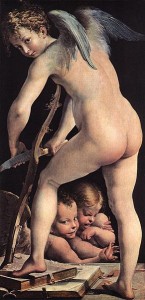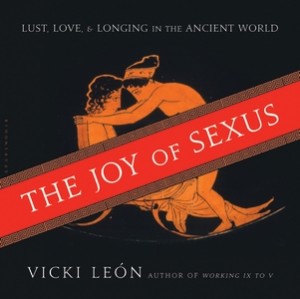By Vicki Leon (Guest Contributor)
 Mid-February in the U.S. brings mushy greeting cards, the overpowering scent of chocolate, and cupids. Lots of cupids.
Mid-February in the U.S. brings mushy greeting cards, the overpowering scent of chocolate, and cupids. Lots of cupids.
Call me a cynic, but I don’t buy that old saw that our Valentine celebrations arose from early Christian activists (all named Valentin) whose bloody martyrdom made this a holiday. And them into saints. (There was one female, a Saint Valentina, but her martyrdom was said to have occurred in July of the year 308.)
Having studied the matter for decades while researching the lifestyles, beliefs, and often quirky customs of long-ago Romans and Greeks, I wager that our sometimes sexy, sometimes loving holiday derives from the pagan side of the equation.
For centuries before Christianity came on the scene, the Romans celebrated a mid-February fertility festival called Lupercalia. (It continued to be honored until the 4th century A.D.) This odd ritual involved a cadre of nearly naked male runners, who roamed the city, lightly whipping every nubile female in sight with bloody strips of goathide. Sounds suspiciously like S&M, but it was a purification ritual. The floggings cleansed the city and chased off evil spirits, making Rome’s women receptive in the most basic sense for procreative sex.
The Greeks of old didn’t celebrate Lupercalia. However, they were the first to come up with a love goddess, Aphrodite, who immediately gave her name to aphrodisiacs, among other things. Her son–we’re still unclear about the father–was Eros, from which comes “erotic.” The Romans enthusiastically adopted both of them early on, calling her “Venus” and her son, “Cupid.”
There was a Greco-Roman obsession with deities. They thought nothing of adding to the already-massive roll-call of gods and goddesses. Thus, at one point, they decided that the love goddess and her sidekick needed help. In nine out of ten myths, she had little maternal control over her son Eros/Cupid, who as everyone knew, was in charge of sexual passion, the juvenile delinquent of the family. (Frightening, the way that kid armed himself with state-of-the-art weaponry.)
Given her deplorable parenting skills, Venus could not keep up with the demands on her time. All those anguished parents, star-crossed lovers, horny teens, forlorn widows, and brides forsaken at the altar needed more divine help. They looked to her for solace. For answers, darn it.
What was the ingenious solution that Greeks (and the copycat Romans) came up with? They took a long hard look at love, lust, and longings, then subdivided those emotions into categories. Once identified, they created a lineup of subordinate demi-gods to handle those calls, so to speak. The concept resembled our smartPhones and answering machines, with their “Press 1, Press 2,” menu choices.
The minor deities that the folks of long ago dreamed up were cuddlesome little rascals. Like Eros/Cupid, they were depicted as young boys or even toddlers. They had rosy, infantile bodies with wings. They ran about nude, playfully shooting arrows and getting into adorable mischief. As a group, they were called the Erotes–the little loves. In art, they often served as the entourage to Eros/Cupid.
Since the Greeks recognized both unrequited love and requited love, they created Himeros and Anteros to report to for people with those afflictions. Or blessings. Popular among the morbidly depressed, love-gone-wrong population was a godlet named Pothos, who commiserated over sexual yearnings. For lovers new to the game, a pair of Erotes called Peitho and Hedylogos handled issues like seduction, sweet-talk, pickup lines, and similar matters.
Taken as a whole, the Erotes provided emotional help and an on-call support group to the general populace.
In addition, the Erotes caused legions of painters, sculptors, and muralists all over ancient Italy, Greece, and the rest of the Roman Empire to breathe a huge sigh of relief. At last! Some fresh new material to work with, a variety of cuddly, fleshy cupids to brighten otherwise humdrum murals, friezes, wine goblets, chamberpots, and more.
 Vicki Leon is a nonfiction author of 37 books, includes this tale and 88 others in her newest book, The Joy of Sexus. (Walker, January 2013).
Vicki Leon is a nonfiction author of 37 books, includes this tale and 88 others in her newest book, The Joy of Sexus. (Walker, January 2013).
